PART 3: SOME LIKE IT HOT
One of the key regions for which I was budgeting my time to spend on the
Rajasthan, featuring some of the most exotic and dazzling places in India
and in the world. The muslim Moghul empire swept across northern India
and when it retreated, it left its artistic mark in no place as indelibly
as in Rajasthan. The intricate detail and explosive colours are what
magnetically attract visitors here. When many people conjure up images
of India, there's a good chance they are images of Rajasthan that are being
envisioned. Rajasthan was active with both tourists and touts when
I arrived, though it was past the peak season. Another reason I was
hoping to arrive in this lowland state as quickly as possible was to see
it before the stultifying heat could set ablaze sleeping cows. Alas,
this plan failed as a late winter heat wave was scorching the area, consistently
pushing the mercury over 40°C every afternoon. But as it
turned out, the intense heat was an intense bone-dry heat, which I don't
really mind so much. Even at its 44°C zenith (about 110°F),
I felt comfortable walking around outside, staying in the shade whenever
possible and drinking buckets of water and soda. I had feared the worst
as far as hassles, extrapolating from what was conveyed by other travellers,
but I didn't really find Rajasthan much more difficult than most other parts
of India. Lone women travellers seemed to have more problems in Rajasthan,
especially on the sexual harrassment angle. And it probably helped
that I chose to skip Jaipur, the largest Rajput city and one vertex of the
infamous scam triangle along with Delhi and Agra.
There was of course plenty to see. My first stop was Udaipur, home
to the lakeside City Palace where the 007 film Octopussy was filmed. Nice
palace, nice enough town with a lake and surrounding hills, but I didn't
really find its reputation as the most romantic city in India much deserved.
The next two sites, which I suffered mightily on excruciatingly slow
local bus rides to visit, were Ranakpur and Mount Abu. I made a point
to visit them because of how an Australian traveller I'd met in Ajanta talked
about them. You know when they start blubbering about a place in a
certain way, you gotta see it for yourself. And I don't regret the
effort I expended. Both cities featured exquisite Jain temples with
intricate carvings from marble that I have never seen anywhere else.
Even the Taj Mahal can't touch these for detail. I don't know
what prompted the Jains, now a minor religious community in India, to build
these temples (perhaps the beauty of the art inside the temple reflected
their belief in worldly austerity comcomitant with inner beauty) but I'm
sure glad they did because I'm not sure if anyone will ever build this again.
The Ranakpur temple is primarily one mother temple, whereas the Dilwara
site near Mount Abu encloses a complex of temples, but they are all stylistically
similar. Mount Abu had the added advantage of being a hill station
reputed to be markedly cooler than anywhere else in Rajasthan and that was
indeed the case. There's not a whole lot of exceptional interest to
the tourist there but it's a pleasant place and since it's primarily a tourist
destination for Indians looking to escape the heat, life is more laid back
for the foreign tourist. Consequently many backpackers end up relaxing
and hanging out in Mount Abu far longer than they expected.
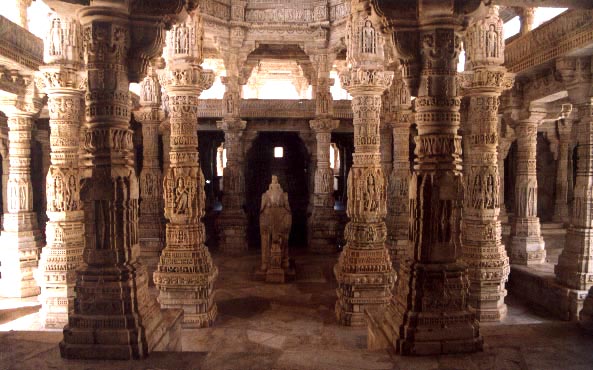
The interior of one wing of the Jain temple at Ranakpur. Yes,
that's all marble that you see.
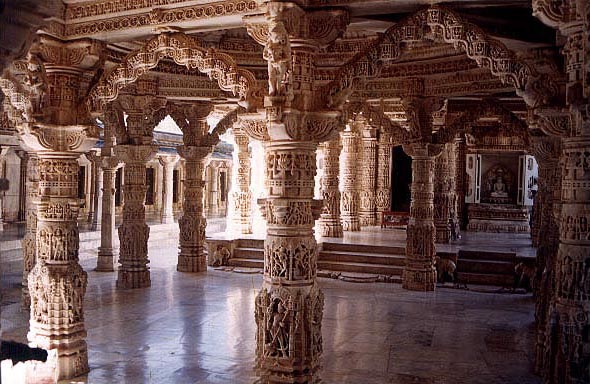
Photography is prohibited at the Dilwara temple, so I bought a
print of this photo that had been taken fifteen years ago. Note the
Jain idol sitting on the back wall.
From the refreshing heights of Mount Abu, it was back into the furnace.
I had only a day to spend in Jodhpur, but that was enough to visit the
imposing Meherangarh fortress dominating the city and to walk through one
of the "blue" neighbourhoods in town. The tradition to paint houses
blue originated to mark homes of the Brahmin caste, but eventually triggered
a chain-reaction that even Picasso in his cubist blue period would have fondly
approved of. Walking through these neighbourhoods was about as viscerally
stimulating as any other I had in India.
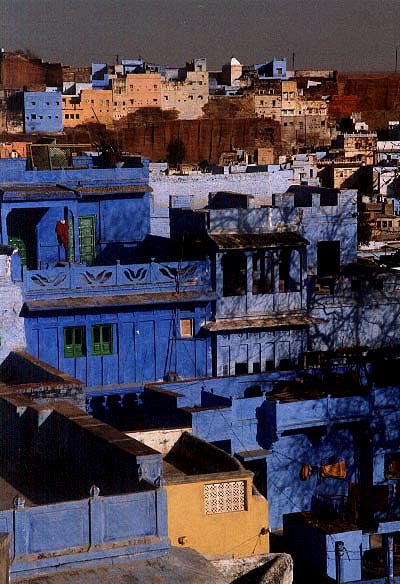
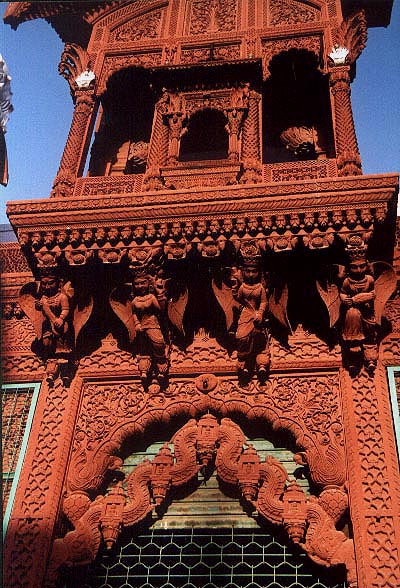
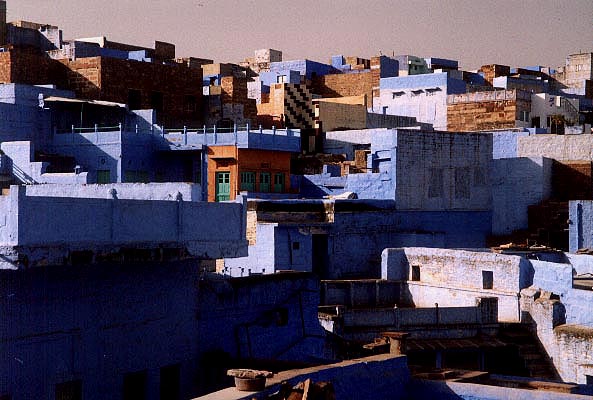
Images from Jodhpur, Rajasthan: the fatehpol old city and
the clock tower from Sadar Market
A westbound train transported me next to Jaisalmer, about as far west as
you can get in Rajasthan, with only the Great Thar desert separating it
from Pakistan. I had heard wondrous tales of this storybook kingdom
rising out of the baked sand, but I was not prepared for how stunningly
complete the fairy-tale was. The walled fortress overlooking the city
contains a mini-world interlaced with alleys so narrow that cows and buffaloes
frequently block pedestrian traffic, with sandstone temples and palaces
poking out over the skyline. Of course there are other tourists and
the commerce of the walled city depends entirely on tourists, but the timeless
medieval feel of Jaisalmer cannot be quenched so easily. The old city
outside the walls is just as beautiful. Every other building seems
to feature impossibly ornate Rajasthani style woodwork and sandstone carving
that would be a museum piece anywhere else. The architecture is as
extensive and coherently uniform in style as Paris orVenice or Miami Beach,
and the desert dryness has preserved the materials superbly. Jaisalmer
gets my vote as the most beautiful city in India.
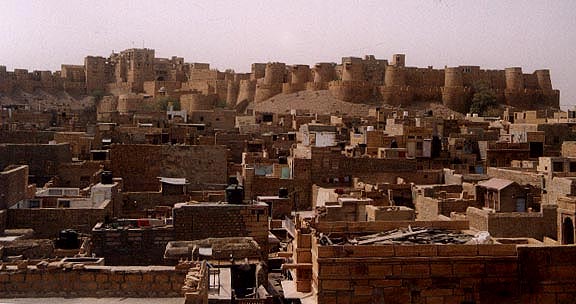
View of the walled city of Jaisalmer, Rajasthan, from the rooftop
of the magnificent Patwon-ki-Haveli historic house
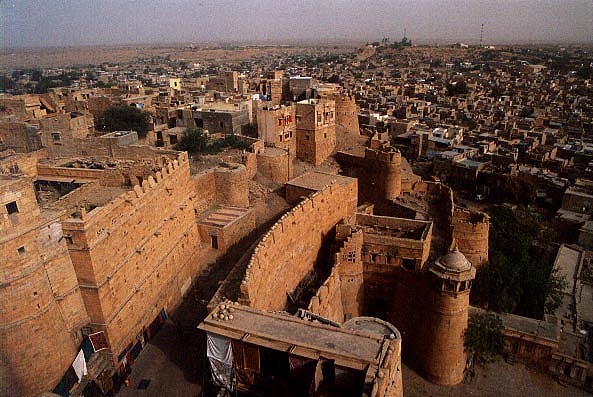
View from the roof of the seven-storey Maharajah's palace inside
the walled fortress of Jaisalmer, Rajasthan
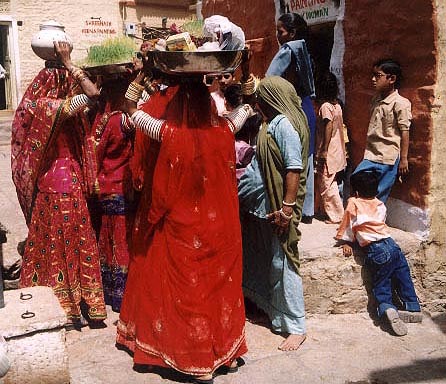
The rajput Isar Gangore festival took place while I was in Jaisalmer,
Rajasthan. Unmarried women sing and bring offerings door to door in
front of the houses of the suitable unmarried young men in town. Their
singing voices weren't so great, but their colourful costumes were quite
photogenic!
I spent more days in Jaisalmer than any other place in India and so I had
time one of those days to take a sunset trip out to the Sam, an outpost
42 km into the desert. Daytrippers get inundated by extremely persistent
hawkers and camel touts who won't get out of your face no matter what you
say. I had no desire to jump on a camel, having done so in Giza, so
eventually I resorted to playing games with these touts who chase you across
and over the sand dunes. I'd start running away from them if one approached
me and when they finally gave up and walked away, I'd playfully walk back
after them. In the end, I learned that the best strategy for not getting
bothered by the touts is to sit near a group of Indian visitors, who'd chase
them away. And while the sunset was obscured by the haze and dust
in the sky, I always enjoy spending a little time in the desert.
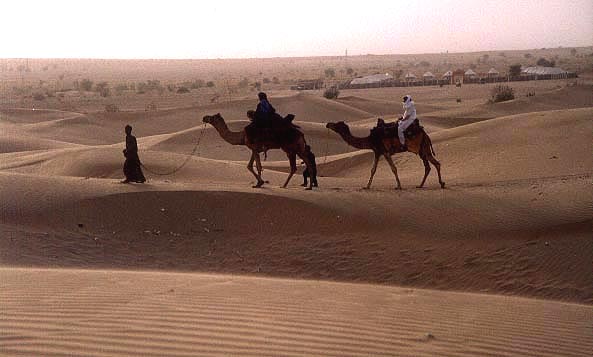
Camel riders at the Sam sand dunes, Rajasthan.
When it was time to move on, the prospect of a very long 18 hour train
ride northward to Punjab awaited me, so I decided to cut the journey with
a few hours in Delhi. I had not anticipated spending any time in Delhi
at all, but a brief visit was educational in any case. On the tourist
front, I managed to walk through the old town of Delhi, which reminded me
very much of medieval Cairo, visit the Jama Masjid, largest mosque in India,
and the Red Fort. None of which I found terribly remarkable. I'm sure
I didn't spend enough time to draw any conclusions, but Delhi is not a terribly
pleasant city. The typical dust and filth and smelliness and chaos
and noise and tenacious touts you see in other cities are simply magnified
n-fold here. Most of the backpackers I talked to who harboured positive
feelings for Delhi turned out to be homesick westerners who in reality enjoy
the convenient services and low prices in the Paharganj tourist ghetto, without
venturing outside its cozy confines. The most fascinating neighbourhood
for me was the upscale Connaught Place concentric circular complex on the
modern New Delhi side of the rail tracks. Here, expensive boutiques
and restaurants (including the only McDonald's I'd see in South Asia -- serving
veggie burgers of course) display a staggering wealth relative to most of
India. The upper crust clientele, even the kids, speak to shopkeepers
and with each other in English rather than Hindi. There may have been
more ATM machines here than all of the ones that I saw in the rest of India
put together. It blew my mind that all this existed barely a kilometre
or two from the impoverished squalor of old Delhi. Clearly India is
a nation of haves and have-nots, brahmins and untouchables, and even when
geographically juxtaposed with each other, never the twain shall meet.
BACK: PART 2 VERY FENI
NEXT: PART 4 FEELING SIKH AND BHANGED UP








